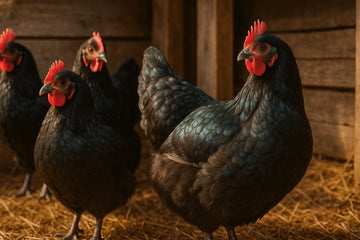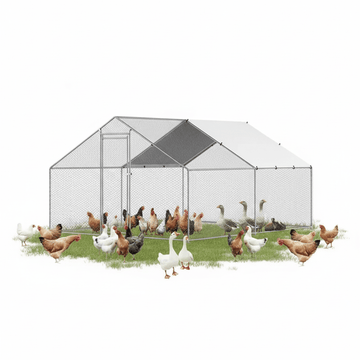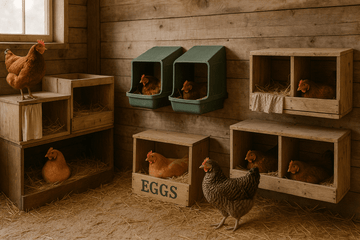If you're exploring the wonderful world of backyard chickens, you've probably heard of Australorps. This breed is a genuine Aussie legend, prized not just for their exceptional egg-laying abilities, but also for their calm nature and adaptability. Wondering why Australorps are the number-one pick for Australian families? Let’s dive into everything you need to know.
Breed Origin and History

Australorps trace their roots back to early 20th-century Australia, specifically bred from the English Orpington chickens. Farmers wanted a reliable egg producer that could thrive in Australia's unique climate. Australorps quickly rose to fame for their incredible productivity and gentle temperament. In fact, they set an egg-laying world record in the 1920s—one hen famously laid 364 eggs in a single year!
Breed Characteristics
Appearance

Australorps are medium to large birds with sleek black feathers that shimmer with greenish-purple iridescence under sunlight. They have broad bodies, deep chests, and a strong, upright posture. Hens typically weigh around 2.5–3.5 kg, while roosters weigh around 3.5–4.5 kg. Their legs and feet are black or slate-coloured, and their eyes are expressive and dark.
Personality and Temperament

These chickens are among the friendliest you’ll encounter. They are gentle, docile, and extremely easy to handle, making them perfect for families and beginner chicken-keepers. Australorps are rarely aggressive, making interactions safe for children and other pets. They also adapt well to being handled, so if you’re looking for cuddly, affectionate poultry, Australorps are the way to go.
Egg-Laying Abilities

Australorps are phenomenal egg layers, typically providing around 250–300 eggs annually. The eggs are large, with a rich, light-brown shell. Their consistent egg production, even in winter months, is a major draw for Australian backyard enthusiasts.
To boost egg-laying performance:
- Provide a balanced diet rich in protein and calcium.
- Ensure they have at least 14 hours of daylight exposure.
- Maintain stress-free nesting boxes.
Health and Common Issues

Australorps are hardy birds with fewer health issues compared to other breeds. However, you should still watch for common chicken health problems like parasites (mites, lice), respiratory infections, and egg-laying disorders.
Simple health tips include:
- Regularly check and treat for parasites.
- Keep coops clean and well-ventilated.
- Provide regular vaccinations and health checks with a vet.
Feeding and Nutrition

Australorps require balanced, nutrient-rich feed to maintain their health and egg production. A quality layer pellet supplemented with fresh greens, kitchen scraps, and grains is ideal. Offer oyster shells or grit for extra calcium to keep their eggshells strong.
Avoid overfeeding as Australorps can become overweight quickly, affecting egg production and overall health.
Ideal Environment and Coop Setup
Australorps adapt well to various climates, making them perfect for Australian conditions. Your coop should provide protection from extreme weather:
- Adequate shade for summer heat.
- Protection from wind and cold drafts in winter.
- Provide at least 1 square meter per chicken inside and about 3–4 square meters per chicken outdoors for roaming.
Use roll-away nest boxes to keep eggs safe from breakage and egg-eating habits—Australorps thrive with such thoughtful accommodations.
Compatibility with Other Breeds

Australorps integrate easily into mixed-breed flocks. Their calm temperament reduces conflicts, and they often take the role of gentle peacemakers. Ideal companion breeds include Sussex, Orpington, and Plymouth Rock chickens, known for similar docile dispositions.
Pros and Cons of Raising Australorp Chickens
Pros:
- Excellent egg-laying capacity.
- Friendly and docile temperament.
- Adaptable to various Australian climates.
- Low maintenance and hardy.
Cons:
- Can become overweight if diet isn't monitored.
- May require extra protection against predators due to their calm nature.
Personal Stories from Aussie Chicken Keepers

Many backyard chicken keepers praise Australorps for being not only reliable layers but delightful pets. Families particularly enjoy their gentle nature, often recounting how these chickens become beloved companions—following them around the yard and even greeting them at the door for treats!
Frequently Asked Questions (FAQs)
1. How long do Australorp chickens typically live?
Australorps usually live for about 6–10 years with good care, but their egg production declines after the first few years.
2. Are Australorps noisy?
No, Australorps are generally quiet birds, making them suitable for suburban backyards.
3. How soon do Australorps start laying eggs?
Most Australorp hens begin laying at around 5–6 months old.
4. Do Australorps tolerate confinement?
Yes, they adapt very well to confined spaces, provided they have adequate room and enrichment.
5. Can Australorps fly well?
Australorps are relatively heavy-bodied, meaning they don’t fly well or far, which is beneficial for backyard settings.
Conclusion
Australorp chickens perfectly blend egg-laying prowess, easy-going temperament, and hardiness into one ideal breed for Aussie backyard enthusiasts. Whether you're just starting or expanding your flock, Australorps provide endless joy and consistent productivity. Are you ready to add Australorps to your backyard flock?







